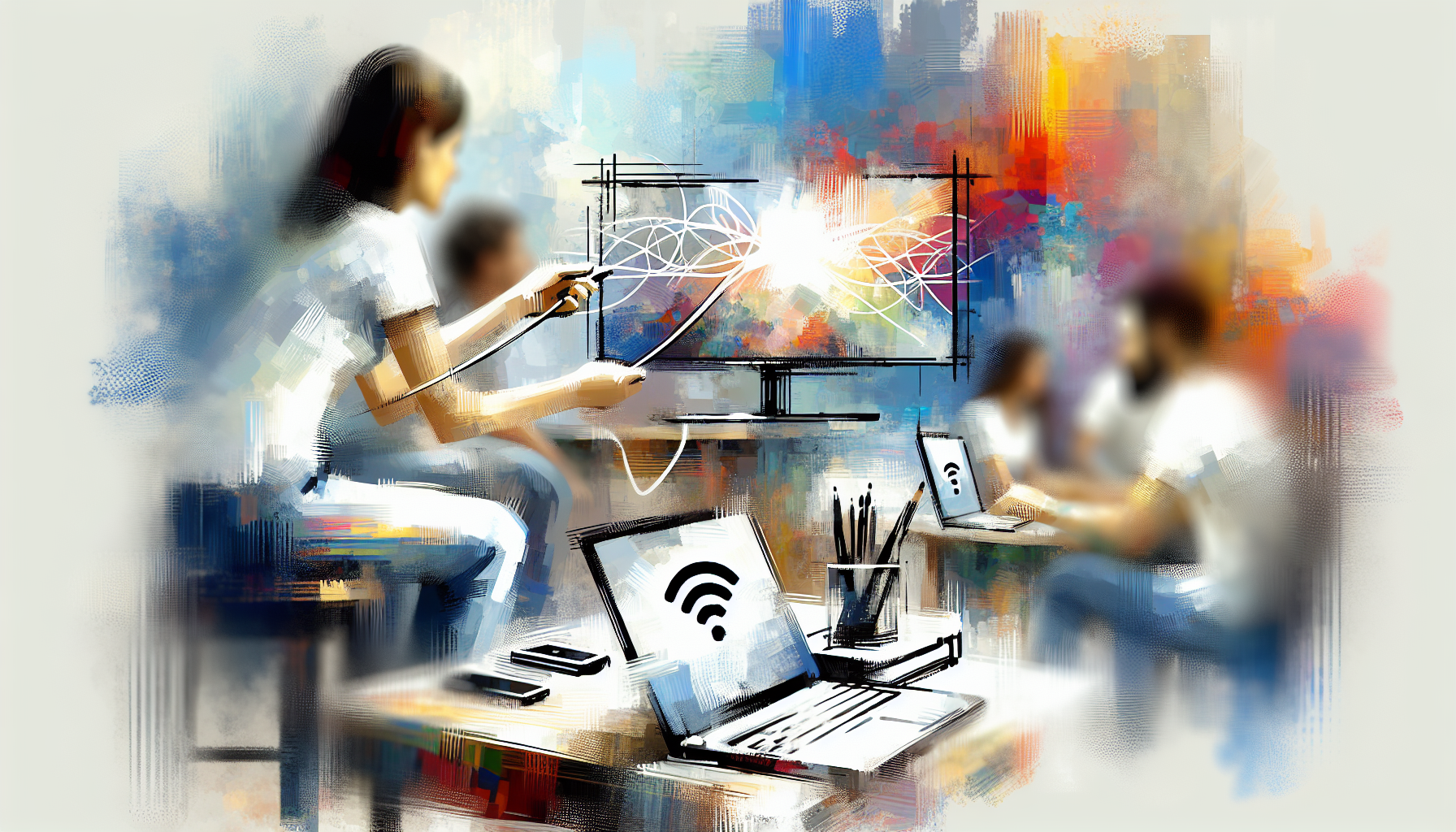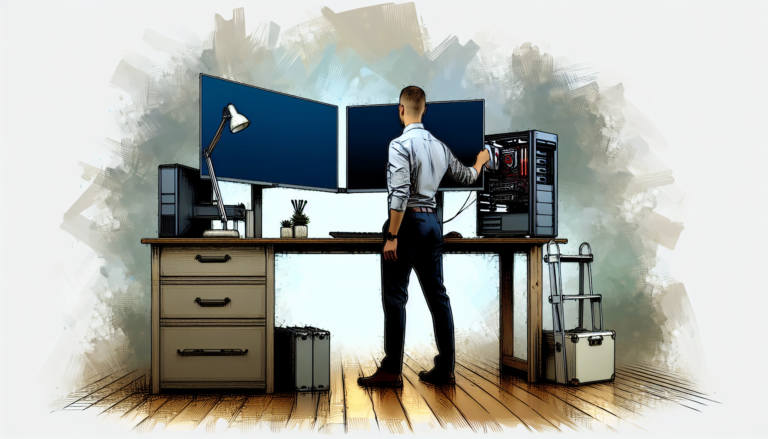Tech Made Easy: How I Wirelessly Connect My Laptop to TV
Connecting Laptop to TV Wirelessly
Alright, so you’re looking to beam your laptop onto the big screen without all those annoying wires getting in the way? I got you covered. Whether you’re trying to watch a thrilling movie or nail that presentation, there are a bunch of ways to make the magic happen. One crowd-favorite trick for Windows 10 users is a neat tool called Miracast.
Wireless Options for Connection
Miracast comes baked right into Windows 10. It lets you broadcast your laptop’s screen to your TV without pesky cables. To kick things off, just hit the Windows key + K. Then, pick your TV from the gadget lineup. Trusty tip: make sure your TV’s on the same Wi-Fi.
Using Miracast for Windows 10
Now, before you go all gung-ho with Miracast, your TV has to speak its language. If you’ve got one of those fancy Bravia TVs and it doesn’t play nice with Miracast, you might need a small gadget as a translator. Keep in mind, though, some streaming apps might not be team players with Miracast, which is a bummer.
Want to cast to another Windows PC? Easy peasy. Flip on that “Wireless Display” toggle in Settings, grab the Wireless Display settings, and fire up Connect. If you need more hand-holding, my buddy Microsoft can break it down for you with a few more clicks.
For those of you craving more freedom, think about a WiGig dock. It’s like your techy best friend that helps you hook up your laptop to different displays like magic. Just make sure your gadgets are WiGig-friendly, power it up, and check it out from the device list.
Need to juggle how your displays work on Windows? Whether you’re doubling up, extending, or keeping it mono, tap the Windows key + P to bring up a menu that makes it all a snap. Whatever setup floats your boat, those keystrokes have your back.
Apple Devices Wireless Connection
Ever tried connecting my Apple laptop to a smart TV without the hassle of cables? It’s surprisingly easy with Apple AirPlay. I mean, who wouldn’t want to stream videos or mirror their computer on a big screen with zero fuss?
Using Apple AirPlay
To get in on this wireless magic, my Apple laptop and smart TV have to be on the same page. What’s important here? Owning either an Apple TV or a smart TV that supports AirPlay 2—think LG, Samsung, Sony, or Vizio models from 2019 onward (Asurion). After enabling AirPlay on my laptop, I just have to pick the right TV input, and bam, I’m watching my favorite stuff on the big screen.
Connecting Macs to Smart TV
The trick to making my Mac play nice with the smart TV is all about the setup. I have to make sure AirPlay is supported and then follow whatever specific steps my TV manufacturer suggests. Whether I’m pulling up a work presentation or diving into a movie night, using AirPlay cuts the cord—literally—and makes it all easy and flexible.
Thanks to Apple AirPlay’s nifty talents, I get this sweet, cable-free link between my laptop and TV. It’s a game-changer for productivity and kicking back with a good flick, all without the usual tech headaches. This blend of ease and Apple’s seamless vibe just nails it.
Wireless Methods for Chromebook
So, you’re looking to make your Chromebook and smart TV the best of friends, huh? With wireless connectivity options, you can kick back and enjoy all your favorite stuff on the big screen. Among the different ways to make this magic happen, Google Chromecast is a top pick for linking your Chromebook to a smart TV.
Google Chromecast Setup
Google Chromecast is like your tech buddy that makes screen mirroring from your Chromebook to your smart TV super easy. Want to watch a movie on the big screen instead of squinting at your laptop? Chromecast’s got you. Setting it up is a breeze, thanks to handy instructions from Asurion’s YouTube magic (Asurion).
Once you’ve got your Chromebook hooked up to Google Chromecast, it’s like opening a treasure chest of entertainment—you can stream everything from movies to slideshows right from your laptop to the TV, all without those pesky HDMI cables. It’s like a mini home theater with sharp visuals and sound that pulls you right in.
Chromebook to Smart TV Connection
Wirelessly connecting your Chromebook to a smart TV? It’s not just geek speak—it actually makes things better. You get clearer pictures, sound that plays nice, and no more squinting at tiny screens during group hangouts.
Lucky for us, newer Chromebooks and smart TVs come packed with wireless screen sharing stuff built right in. So, setting them up is as easy as pie—no need to be a whiz with tech. It makes watching Netflix or showing off your vacation pics to friends a breeze (Ask.com).
With Google Chromecast, you can easily make your Chromebook and TV the dynamic duo of entertainment and work. Want to stream the latest blockbuster, show a killer presentation, or team up with your work buddies? Chromecast keeps things smooth without the hassle.
Compatibility and Setup
Hooking up your laptop to your TV without getting tangled in cables? Let’s make sure everything plays nice together and stays secure.
Device Compatibility Checks
Before diving into the screen-sharing pool, make sure your devices can play ball. Most laptops and smart TVs these days come ready with wireless sharing flair, making life a breeze (Ask.com). This stuff usually works out of the box, no sweat.
The trick is making sure your laptop and TV are gossiping on the same Wi-Fi network. Just stick to what the manual says, and you can flick between screens or stretch your laptop view onto the TV in no time (Ask.com).
Establishing Secure Connections
To keep pesky intruders at bay and amp up your security, try some of these simple steps:
-
Change Your Router’s Hello: Swap out that boring default login info for something fresh. Default settings are like leaving your door wide open. Sprucing up your username and password locks it up tight.
-
Go Pro with WPA3: This Wi-Fi security jazz, called WPA3, is like hiring a digital bodyguard. Hat tip if your gadgets can handle WPA3—lock it down with a strong password. Keeps your network out of trouble.
Checking that everything matches up and beefing up security lets you hook your laptop to your TV with ease. Kick back and share the laptop love on the big screen while keeping your network safe and sound.
Troubleshooting Wireless Connections
Connecting your laptop to your TV without wires can be about as fun as finding Wi-Fi at your favorite coffee shop: easy when it works, rage-inducing when it doesn’t. But hey, we’re here to arm you with a few tricks that will make those “connected but not really” moments less annoying.
Common Connectivity Problems
-
Mix and Match Issues: Sometimes, your laptop and TV just don’t see eye to eye—and that can mess up the flow. Your trusty laptop might not like what your TV’s putting down, leading to a shaky connection.
-
Wi-Fi Drama: Other gizmos in your house or that noisy neighbor’s Wi-Fi can mess with your connection too. You’ll get buffering spells, or even those dreaded ‘signal lost’ messages.
-
Settings Slip-Ups: Maybe your laptop or TV isn’t set up quite right. Double-checking settings on both ends gives them a better shot at working together without the cold shoulder treatment.
-
Who Needs Updates?: You know how your devices nag for updates? Well, ignoring those could be why nothing’s working. Keep your tech up to date so they can be BFFs again.
How User Manuals Can Help
If your TV and laptop are in the middle of a spat, cracking open their respective user guides can be like calling in a therapist. Each comes with step-by-step instructions designed to get them talking again.
When unsure about how to tweak a setting or two, your manuals are the first place to check. You might find that one setting you needed to flip all along—or it might advance you straight to plan B.
And if you feel like you’ve tried everything but they’re still giving you the silent treatment, it might be time to call in reinforcements, aka customer support. These folks can walk you through the nitty gritty specifics, tailored to your particular laptop and TV models, so you aren’t left guessing—and can enjoy that show or presentation without a hitch.
By digging out those user manuals and leaning on customer support when all else fails, you can troubleshoot like a pro. Get your laptop and TV working together as a united team to make your streaming dreams come true.
Beef Up Your Wi-Fi
Who doesn’t love buffering? That spinning wheel giving you a meditation break? Okay, maybe not. To keep your wireless connection in your home purring like a kitten, think about where you park that router and slap on some good ol’ security safeguards.
Playing Hide and Seek with Your Router
Where you set up your router can make your internet fly like a superhero or crawl like a snail. Mind these tips and maybe you can skip the ‘where’s my Wi-Fi?’ dance.
-
Center Stage: Pop that router dead in the middle of your home. It should feel the spotlight and give love to all corners of your kingdom. A center stage swoon means fewer hiccups and stronger signals.
-
Obstacle Course? Skip It: No one likes a crowded track—your signal’s no different. Routers want no walls, no metal jazz. Think open ground, like a mini router field day!
-
Up, Up, and Away: Give that router some altitude. Not climbing-mount-everest kinda thing, just a bookshelf will do. Higher ground, clearer sound—or signal, as it were.
For the nitty-gritty on sprucing up your wireless nest, try Microsoft.
Keep Creeps Off Your Wi-Fi Turf
Fair warning: your digital fortress needs some defense, too. Let’s lock it tighter than a drum:
-
New Name, Who Dis?: First off, toss those default usernames and passwords in the “meh” bin. A unique combo means only you dance the Wi-Fi waltz.
-
Bring on the WPA3: Fancy talk for ‘Keep Out’. If your router’s hip enough to roll with WPA3, grab it. It’s like hiring a bouncer with a strict list—but here, the list is just you and yours.
Rethink where your router lounges and lock down your network, and you’ll be cruising with the ease of Sunday mornings rounded up with buttery pancakes. Wipe out the Wi-Fi worries and stay safe from those lurking cyber gremlins.


